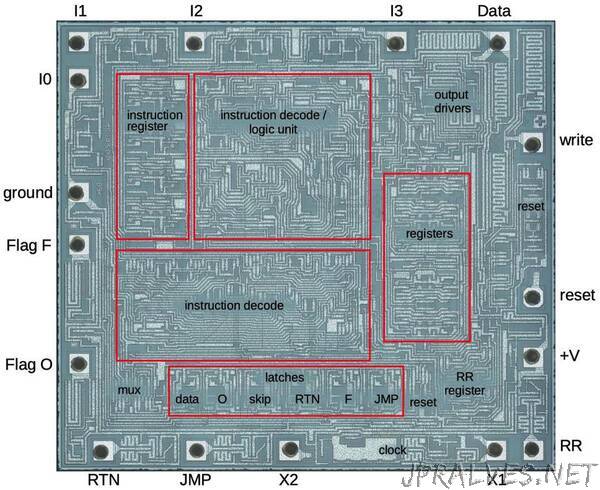
“The Motorola MC14500B1 is a 1-bit processor introduced in 1976. While a 1-bit processor might seem almost useless,2 it was marketed as an Industrial Control Unit for applications that made simple decisions based on Boolean logic, for example, air conditioning, motor control, or traffic lights.
The die photo below shows the processor under a microscope. This silicon appears greenish, while the white lines on top are the metal layer that wires the transistors together. The 16 black spots around the edges are the bond wires that connect the chip to its 16 external pins. The MC14500B has roughly 500 transistors, very few for a microprocessor. In comparison, the popular 8-bit Z-80 microprocessor, also released in 1976, had 8500 transistors. Even the first microprocessor, the 4-bit Intel 4004 (1971), contained 2250 transistors.
You might think that a 1-bit processor would only support two instructions, making it impractical. However, like many processors, the MC14500B uses different sizes for data and instructions. Although it used one bit for data, its instructions were 4 bits, giving it a small but usable instruction set of 16 instructions.3
The MC14500B has an unusual architecture, making it more of a building block than a complete microprocessor. In particular, the chip doesn’t include any support for memory or addresses; it didn’t even have a program counter. The program counter, instruction fetches, jumps, subroutine calls, and I/O needed to be implemented with external circuitry.4 This is a key reason that the chip was so simple. (The other reason, of course, was that it only supported one bit.)
Since the MC14500B was designed for industrial control applications, you’d expect it to be a microcontroller, but it’s the opposite of a microcontroller in many ways. A typical microcontroller is a computer-on-a-chip including RAM and ROM, with strong I/O support, providing a single-chip solution. The MC14500B, however, requires multiple external chips to make it usable.”
